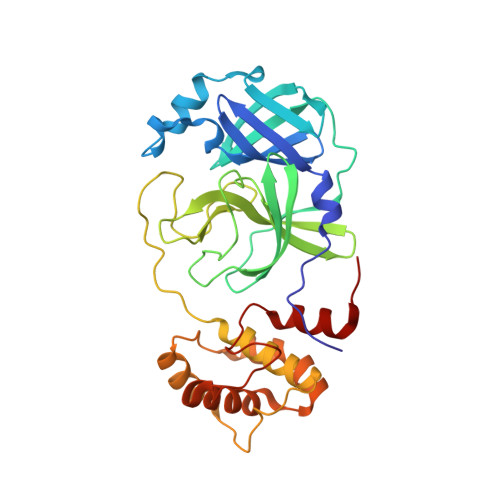Ultralarge Virtual Screening Identifies SARS-CoV-2 Main Protease Inhibitors with Broad-Spectrum Activity against Coronaviruses.
Luttens, A., Gullberg, H., Abdurakhmanov, E., Vo, D.D., Akaberi, D., Talibov, V.O., Nekhotiaeva, N., Vangeel, L., De Jonghe, S., Jochmans, D., Krambrich, J., Tas, A., Lundgren, B., Gravenfors, Y., Craig, A.J., Atilaw, Y., Sandstrom, A., Moodie, L.W.K., Lundkvist, A., van Hemert, M.J., Neyts, J., Lennerstrand, J., Kihlberg, J., Sandberg, K., Danielson, U.H., Carlsson, J.(2022) J Am Chem Soc 144: 2905-2920
- PubMed: 35142215
- DOI: https://doi.org/10.1021/jacs.1c08402
- Primary Citation of Related Structures:
7AU4, 7B2J, 7B2U, 7B5Z, 7B77, 7BIJ, 7NBT, 7NEO, 7O46, 7QBB - PubMed Abstract:
Drugs targeting SARS-CoV-2 could have saved millions of lives during the COVID-19 pandemic, and it is now crucial to develop inhibitors of coronavirus replication in preparation for future outbreaks. We explored two virtual screening strategies to find inhibitors of the SARS-CoV-2 main protease in ultralarge chemical libraries. First, structure-based docking was used to screen a diverse library of 235 million virtual compounds against the active site. One hundred top-ranked compounds were tested in binding and enzymatic assays. Second, a fragment discovered by crystallographic screening was optimized guided by docking of millions of elaborated molecules and experimental testing of 93 compounds. Three inhibitors were identified in the first library screen, and five of the selected fragment elaborations showed inhibitory effects. Crystal structures of target-inhibitor complexes confirmed docking predictions and guided hit-to-lead optimization, resulting in a noncovalent main protease inhibitor with nanomolar affinity, a promising in vitro pharmacokinetic profile, and broad-spectrum antiviral effect in infected cells.
Organizational Affiliation:
Science for Life Laboratory, Department of Cell and Molecular Biology, Uppsala University, SE-75124 Uppsala, Sweden.
















